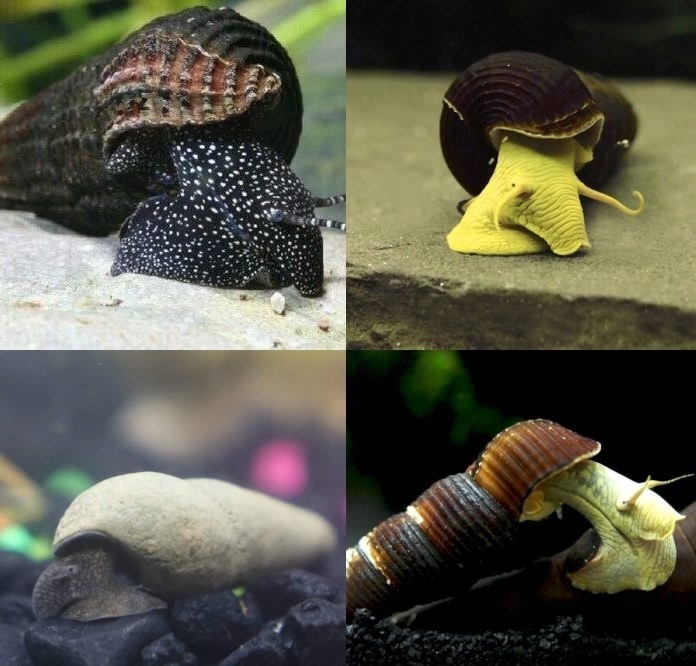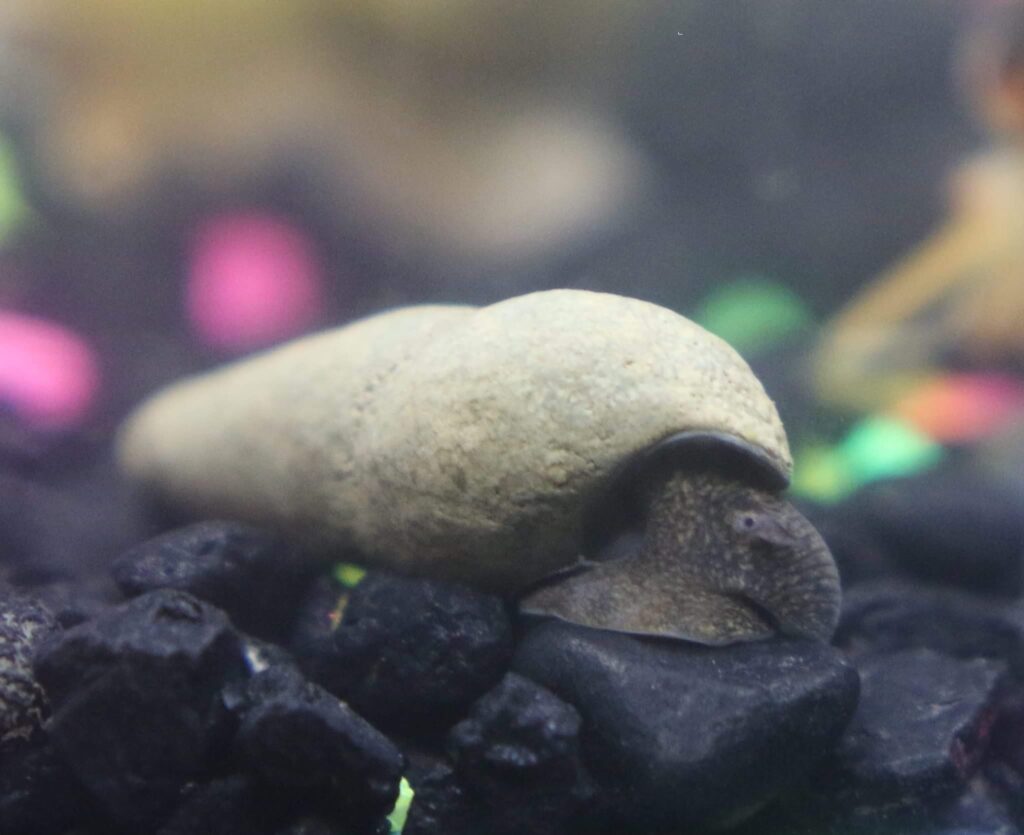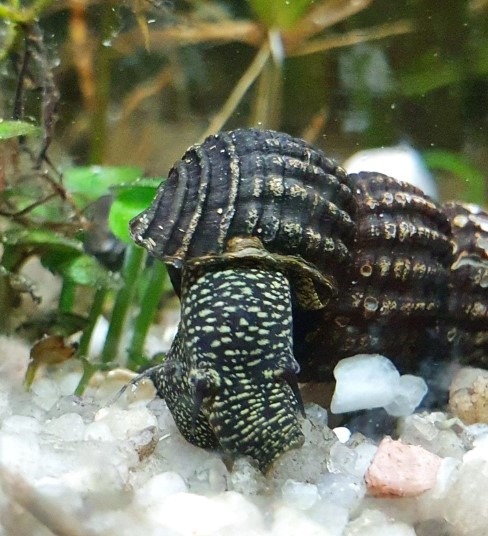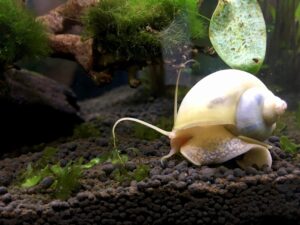
10 Amazing Rabbit Snail Colors (With Pictures!)

Writer at The Aquarium Keeper
Rabbit snails are becoming more and more popular in the aquarium hobby. These creatures can be very unique-looking, compared to the more classic nerite or mystery snail options. I believe, that people constantly are looking for more unique pets for their aquariums, and rabbit snails are one of those species. There are a lot of rabbit snail colors to choose from, but some are harder to find than others. In this article, I will break down 8 rabbit snail colors, that I managed to gather enough information about.
Rabbit Snail Species Overview
To begin, we can’t jump into rabbit snail colors just yet. As a fishkeeping blogger, I feel the need to shortly introduce the species, so that if you decide on buying a rabbit snail, it would be a more informed decision. Essentially, you would know the basic rabbit snail care, and would manage to look after them. Here is the basic information about rabbit snails:
- Water Temperature: 26–30 °C (79–86 °F)
- pH: 7.5–8.5
- Minimum Tank Size: 5 gallons
- Diet: Rabbit snails are considered herbivores since mainly they eat algae, and decaying plant material. These snails can also be partially omnivorous, because they can feast on fish food, pellets, and even deceased tank mates
- Tank Setup: Aquarium should have a filter, heater, and light installed, also preferably sand substrate, so it would be easier for these snails to move
- Temperament: Very peaceful
- Tank Mates: Only peaceful aquatic creatures can be kept with rabbit snails. Small nano-fish, other snail species, or shrimp are excellent tank mates
- Decorations: Rabbit snails really do not care about their surroundings, but driftwood, rocks, and plants would improve the overall aquarium health
- Lifespan: 2-3 years
- Breeding: Rabbit snails are slow breeders, compared to other snail species. Males and females become sexually mature when they become 1 year old. The male fertilizes a female rabbit snail, she then carries the egg inside her shell, and after 4–6 weeks the female will release a few white eggs. Only a few rabbit snails will hatch from those eggs.
- Size: up to 3 inches (7.6 cm)
- Care Level: Easy
- Common Problems: Sudden water parameter changes are one of the leading causes of dead snails in an aquarium. This also applies to rabbit snails, since these species don’t have a very strong immune system and can be harmed by sudden changes
Overall rabbit snail eggs are relatively easy pets to take care of. They don’t pay too much attention to their surroundings, and do well in almost all environments if the water parameters are right. Rabbit snails can easily be considered beginner pets, and I would really recommend a newcomer to this hobby start with a snail aquarium.
Rabbit Snail Colors
Every rabbit snail is literally unique and can differ from the same snail species in shell coloration, pattern, and body color. Even though individual rabbit snails are almost always slightly different from one another, there are mainly 8 rabbit snail types, that can be grouped by their appearance.

Yellow Rabbit Snail
Firstly, one of the most common rabbit snail types is the yellow rabbit snail. Even though it is one of the most basic rabbit snails, the coloration of this type makes it one of the most beautiful ones too.

Yellow rabbit snails can have different shell colors. The coloration can vary from grey, to brown, or even black. The body and the antenna of the rabbit snail are bright yellow, or can sometimes be slightly greenish. Here is more information about these species:
- Scientific Name: Tylomelania “yellow” poso
- Rarity: Common
- Price: 3$–5$ per snail
It is widely known, that aquarium snails look better, and have improved coloration, if the conditions are right, and the food sources are good. This simply also applies to rabbit snails. If you want a yellow rabbit snail, that really stands out, use quality food and ensure the right water parameters.
You might also like to read: 13 Different Types of Nerite Snails You Should Have
Orange Rabbit Snail
Moving on, a slightly different rabbit snail from the previous one is the orange rabbit snail. Is also a very common rabbit snail type, but one of the most beautiful ones too.

Every single individual orange rabbit snail can differ in appearance. Most of the time, the shell is brown, black, and grey in color, and will have some sort of line pattern. The body of the rabbit snail is bright orange, including the long antennas of these species. Here is more information about orange rabbit snails:
- Scientific Name: Tylomelania “yellow” poso
- Rarity: Common
- Price: 3$–5$ per snail
Orange rabbit snails can be excellent if you have a heavily planted aquarium. The orange coloration from the body of the snail will make it stand out in the tank. This can be an amazing view and is a good pet option if you want a wider coloration in your aquarium.
White Rabbit Snail
Another relatively basic rabbit snail type, but harder to find, is the white rabbit snail. It is not as widely popular or available, since the other rabbit snail options are more appealing and unique than this one.

Even though this rabbit snail type is not that colorful compared to others, it is almost always more expensive. The shell of a white rabbit snail can be brown, black, grey, or white, and the body coloration is usually white with some grey markings. Sometimes a white rabbit snail can also look slightly bright yellowish, and this makes sense because it is bred from a yellow rabbit snail. Here is more information about these species:
- Scientific name: Tylomelania “white” poso
- Rarity: Rare
- Price: 5$–10$ per snail
White rabbit snails would look better in darker aquarium setups. This can be blackwater aquariums, or simply a tank with darker background and substrate.
Black Rabbit Snail
Moving on, a more unique-looking rabbit snail is the black rabbit snail. The name explains everything, the snail is usually all black! It is a rare type of snail, which is why it is more expensive.

Black rabbit snails mainly differ in the coloration of the shell, while the body is always completely black. The shell color can be brown, white, grey, or black. It is also common that the shell has multiple colors. Here is more information about these species:
- Scientific name: Tylomelania “black” poso
- Rarity: Very rare
- Price: 7$–15$ per snail
Black rabbit snails are not that appealing in darker aquarium setups. You would not see your snail if you keep it in blackwater tanks or aquariums with darker substrate or background. I would recommend keeping black rabbit snails in more open and brighter setups so that you could see your pet exploring.
White-Spotted Rabbit Snail
The white spotted rabbit snail is the first snail on this list, which is multi-colored when it comes to the body of the snail. It is a unique type, and widely popular among fish keepers.

The white-spotted rabbit snail can have a black, white, brown, or grey shell. Usually, the shell of these species will have multiple colors and a unique line pattern. The body and the antennas are all black, covered in small white dots everywhere. Here is more information about this rabbit snail type:
- Scientific name: Tylomelania patriarchalis
- Rarity: Rare
- Price: 5$–10$ per snail
Similar to black rabbit snails, this type would probably look the best in an aquarium with a whiter substrate, or a brighter light. Some dots on this snail can be bigger, some smaller, but it still is a remarkable rabbit snail type, that takes the place of one of the best-looking snails in the hobby.
You might also like to read: 8 Amazing Mystery Snail Colors (With Pictures!)
Yellow Antenna Rabbit Snail
Moving on, another interesting rabbit snail type is the yellow antenna rabbit snail. Just as the name tells, this particular type of snail has yellow antennas! It is a very desired rabbit snail type amongst fish keepers and is not that widely available.

Yellow antenna snails also have a black body, that is covered with small yellow dots. This type also has matching lips, that are yellow! The shell of the yellow antenna rabbit snail can be a few different colors: black, brown, white, grey, or even multi-colored. Here is more information about these species:
- Scientific name: Tylomelania gemmifera
- Rarity: Rare
- Price: 5$–10$ per snail
It is actually really easy to confuse yellow antenna rabbit snails with white-spotted rabbit snails. The key difference is the yellow antennas and the coloration of the dots. White-spotted rabbit snails also don’t have yellow lips.
Chocolate Rabbit Snail
A very strange-looking and not that popular rabbit snail type is the chocolate rabbit snail. The appearance is nothing special, but the fact, that it still looks different from other snails, makes it a necessity to include it in this list.

The appearance of this snail is really simple: it has a grey or brown shell, and a black body, covered with small orange or yellow dots. The chocolate rabbit snail is considered “chocolate” because of its shell coloration. Here is more information about this rabbit snail type:
- Scientific name: Tylomelania perfecta
- Rarity: Rare
- Price: 5$–10$ per snail
The chocolate rabbit snail would look absolutely amazing on the darker substrate because the color of the shell and the substrate would create a contrast between the coloration. There is also a good chance, that this type of rabbit snail would do the best in nature, because the shell would literally blend in with lighter sand and rocks, making the snail less visible to predators.
Yellow Flake Rabbit Snail
Moving on, another rabbit snail type that has a unique coloration pattern is the yellow flake rabbit snail. It can look very similar to the yellow antenna rabbit snail, but is it a whole different rabbit snail type.

- Scientific name: Neocaridina davidi var. “Red”
- Rarity: Rare
- Price: 5$–10$ per snail
Yellow flake rabbit snails are relatively hard to come by, only being available from a few online aquatic shops. It is possible, that the snail is not that widely known yet, hence the limited availability.
Yellow Spot Rabbit Snail
Another slightly different rabbit snail type is the yellow spot rabbit snail. It is very similar to the white-spotted rabbit snail, but this type only has yellow spots! Even though the appearance is slightly different, this snail is classified as another type of rabbit snail species.

The yellow spot rabbit snail can also be confused with the yellow antenna rabbit snail or the yellow flake rabbit snail. The key difference is that this type does not have yellow antennas. The body of the snail is black, covered with very small spots, unlike yellow flake rabbit snail, whose spots are large and inconsistent.
- Scientific name: Tylomelania towutica
- Rarity: Rare
- Price: 5$–10$ per snail
The shell of the yellow spot rabbit snail can come in multiple different colors: black, white, grey, or brown. There are instances, where even some red color can be visible on the snail shell.
Triangle Rabbit Snail
The last rabbit snail type on this list is the triangle rabbit snail. It is a very rare type, that is only available from a few online aquarium stores. The appearance of this snail is completely different, compared to other rabbit snail types on this list.

The key contrast between the triangle rabbit snail and the previous types mentioned on this list is the shell of the snail. It is not long, and not conical-shaped. The shell usually is brown, black, or white. It is also small and compact, visually resembling a triangle.
- Scientific name: Tylomelania sinabartfeldi
- Rarity: Very Rare
- Price: 10$–20$ per snail
Triangle rabbit snails also have a black body, that is dotted with yellow or white spots. It is truly the most remarkable and unique rabbit snail type on this list.
Frequently Asked Questions
How Many Rabbit Snails Per Gallon?
The ideal rabbit snail stocking is 5 gallons per snail. Even though these creatures don’t eat too much and are not very big, they need at least 5 gallons of water to live a normal life.
Do Rabbit Snails Hibernate?
Rabbit snails don’t hibernate. It is completely normal if a rabbit snail stays in one place for a few days because most aquarium snails usually rest in cycles. They move for a long time and then sleep for a longer time.
Writer's Thoughts
I haven’t had the chance to keep all of the rabbit snail colors mentioned above, but the ones that I did are truly amazing. Rabbit snails are essentially very easy creatures to take care of, so make sure to find the best type of rabbit snail, that suits your interest best.
If you enjoyed reading our article, please feel free to share it with your friends by clicking the social media buttons below:

Thank you for reading my blog post. This website was created with the sole intention of providing quality information regarding fishkeeping. I have been in the fishkeeping hobby for 8 years, and through many trials and errors as well as online research I gathered a lot of information, which I want to give back to the community.





